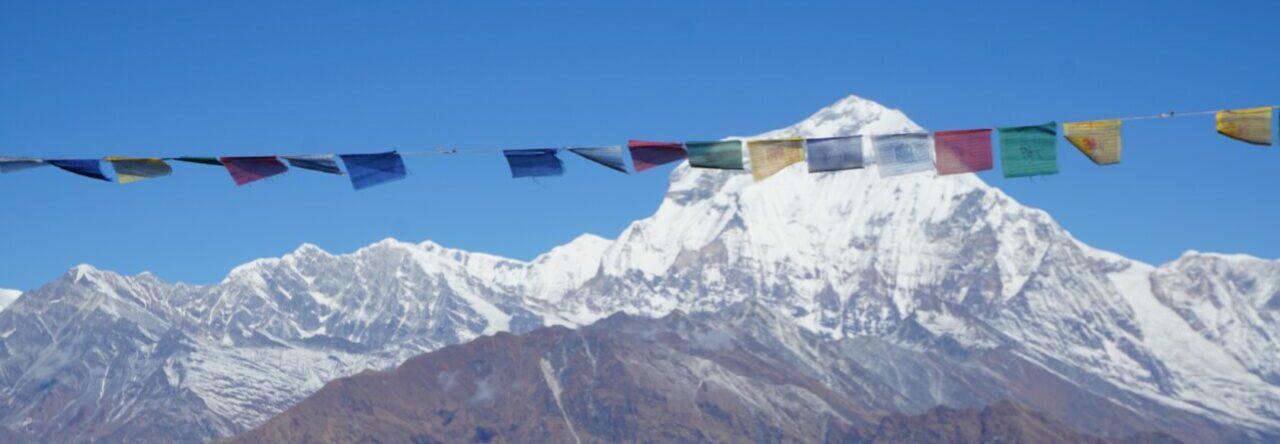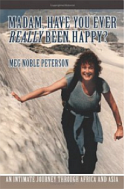One thing for sure about my travels in India: I’ve seen the countryside down and dirty and up close. You worry about the danger to pedestrians and passengers as you’re skimming along over narrow, bumpy roads in an auto rickshaw (tuk tuk) or a battered old bus, but you soon realize that you’re not going very fast. One hundred kilometers in three hours is not exactly flying! And you can see a lot of landscape along the way.
One such bus got Gullvi and me from Jalgaon to Fardapur, a stone’s throw from the famous Ajanta Caves. There we found a reasonably priced guesthouse, The Holiday Resort, run by the government, and we proceeded to bone up on the caves by buying AJANTA, A brief History and Guide, by Walter M. Spink, Ph.D (1954) Harvard, and professor emeritus of the History of Art at the University of Michigan, Ann Arbor…and the world’s expert on caves in the Ajanta Valley.
But where to begin? There are over 1200 caves in India, 1000 of which are in the Maharashtra region, because the hard volcanic basalt rock from which the monasteries, temples, and intricate carvings are made is in abundance in the region. And we learned that it had all been created by using a simple hammer and chisel! Can you imagine carving into a mountain with such elemental tools?
Ajanta was described as a human-made excavation cut into the horseshow-shaped scarp of a steep cliff overlooking the Wagora River. It represents two distinct movements in Buddhism, the first six caves dating from approximately the 1st century B.C.E. and the others from the 5th century C.E. They all reflect the Indian genius for sculpture, and are covered with elaborate decorative details.
The twenty-nine Buddhist caves near Ajanta form a devotional complex, which ranks as one of the world’s most startling achievements, created at the very apogee of India’s Golden Age. And all of this was discovered only 200 years ago by an English soldier out tiger hunting. The caves he found, initially, were from 100 BC to 150 AD, when Buddhism flourished throughout western India, before its three-century eclipse. But that was just the beginning, according to Dr. Spink. It was not until about 462 that a remarkable Buddhist renaissance began at Ajanta under the aegis of the Vakataka emperor Harisena, the greatest ruler of the mid-fifth century. By the end of his brief reign (c. 460-477) his domains in central India stretched from sea to sea.
Nearly all the Vakataka caves were started in a single burst of activity, using the skills of artisans sent down from the great cities, and drawing sustenance from the nearby trade route which Harisena’s forceful rule made safe for the monks, merchants, and workers who traveled upon it. Having received a pious patronage from rival dynasties that resulted in intense development, Ajanta’s splendid murals, telling old Buddhist tales in modern dress, provide a remarkable “illustrated history” of the period.
These words are a summary of some of the material to be found on Dr. Spink’s website (www.walterspinik.com) along with his controversial theory that all of the later caves were completed within only fifteen years, an amazing feat, which he likens to a Renaissance (462 to 477 C.E.). There are also several videos, which will give you an idea of the vastness of the temples and the artistry of the painting and statuary uncovered in the caves (videos for www.walterspink.com).
After having devoured the guidebook, you can imagine our surprise and glee at having a charming man walk up to our table in the dining room and ask if he could join us. He said he was here for several months to continue his research and writings about the caves. Name? Walter Spink. How lucky can you get? Gullvi and I spent a good part of the next two evenings questioning him about the way in which the caves were created, and talking with him about his research. Here was a man who still, in retirement, worked with teams of students from around the world at his site seminars, was writing another book, and had a sense of humor about the idiosyncrasies of the academic establishment. A man with a twinkle in his eye and a razor sharp mind. What a joy for us!

Walter M. Spink
Walter suggested that we take a taxi through the old town of Ajanta early the next morning, which would take us through the gate of the ancient wall and on to the Viewpoint, a high ledge from which we could see the entire horseshoe-shaped layout of the caves. We could then walk down a steep series of steps to a gazebo and there, spread out in front of us would be the entire panorama. We took his advice.

The caves from the Viewpoint




We spent a glorious, albeit very hot day, walking in and out of the most amazing structures I’ve ever seen. This is a must for all travelers to India! Get there at all costs. It’s one thing to see glorious temples built of stone, and it’s another to see temples carved OUT of a stone cliff. In this case, seeing is believing.
I took over a thousand photos of these structures, inside and out. Each pillar had its own special design, and was meticulously situated according to elaborate architectural plans; each frieze was different; and each ceiling individually painted or carved. Here is a tiny sample of what I saw. I have not attempted to name each photo.

Vaulted ceiling

Detail of ceiling in entranceway

Inside one of the many temples

Chaitya Hall


Detail of frieze on pillar



One of the most enjoyable parts of our visits to the caves was the communication with the school children. Droves of young people, squired by their teachers, filed in and out of the temples, and whenever they’d see us Westerners, they’d shout,” Hello, welcome to India. My name is ____. What is yours?” Then a dialogue would ensue and, soon, photos taken, in groups and individually. They loved to pose with us! And ask us what we thought of their country. Did we like it? And what did we like about it? And would we come back? There was a real desire to hear good things about their history, for they knew too well the unattractive things, like the garbage and pollution. So we interacted, talked with the teachers, and ended up shouting goodbyes interminably. We were always treated with great respect…called Madam, Amala (mother honorific), or even Grandma. And everyone wanted to shake our hands. It was delightful.

They sang to me as I taped them


Goodbye, Meg…Goodbye, Gullvi!
Indians are encouraged to visit their national treasures, which is why the admission is only a few rupees for them as compared to the large amount for foreigners. Gullvi and I never minded this, for we realized how much it takes to care for these sites, and we also realized how important it is for the people of the country to know and be proud of their rich heritage. We even became friendly with some of the hucksters who were pushing guidebooks and trinkets. At one point I told my pursuer for the tenth time that I did NOT want to buy anything. Finally he said, “That’s all right, Madam. My job is to ask and your job is to say no. So, today, we’ve both done our job.” How about that?

My friend, the book salesman…also a reporter for the local police department
It was Walter who urged us to continue on to the Ellora Caves after two days in Ajanta, and then to return, pick up our packs, and have some tea before heading back to Jalgaon and our train to Katni. What a great idea!
Our bus ride to Ellora was much more eventful, if roaming around, looking for some kind of transport qualifies. I have to admit that I was taken back to former days when I found excitement in this kind of bare-bones travel…standing by the side of the road waiting for a bus, bargaining for bananas and oranges from a vendor, putting up with stares and giggles from the locals. We really were a curiosity…two older ladies traveling like natives, with no pretences.
We reached the small town of Phulambri, where the road to Ellora turned off, and were admonished to “go that way” to find a bus or taxi. We finally located a makeshift taxi (more like a panel truck), climbed aboard, and waited until 24 people had been stuffed in (I think they overreached their quota, actually). This is the ride I told you about earlier, with the old woman crammed into the front seat under the fat man, along with four other people. Since Gullvi and I had paid four times as much as the Indians, we weren’t about to double up any more, and stood our ground.
You cannot imagine that ride! The left door would not close entirely and the poor old woman was grasping the dashboard to stay inside. Every time we’d stop, the man in charge would try to get us to move closer together so he could add another passenger, but we refused. Only when we halted five kilometers from the caves did we get bamboozled. We were transferred to an even more beat-up cab, driven by a crazy young man, who seemed to be trying to terrify us, as western women, by playing chicken with every oncoming vehicle. This was done by swerving across both lanes of a narrow road, passing on hills, looking back and laughing, and picking up or disgorging numerous teenagers along the way. His door didn’t close, either, and at one point he folded his legs under him to show us that he really didn’t need brakes. I was so busy praying to the God of Rapid Transit, that I simply stopped paying attention to him, looked to the left, watched the sun set, and thanked Shiva, Buddha, and Jesus when I arrived at the Kailas Hotel, our destination.
Early the next morning we ran the gauntlet through hordes of eager shop keepers to the gates of Ellora. For two days we roamed the hills, alive with monkeys, and marveled at the magnificent caves, especially #16, Kailasa, which is considered the zenith of the rock-cut technique of architecture. Pictures cannot begin to show the majesty of the carvings, the human figures in bas-relief, the huge stone elephants adorning the courtyard, the balconies with their columns and secret rooms, and the monolithic Kailasa temple, named after the mountain abode of Siva, which rises out of the center courtyard. You can view and study many of these temples on line and in the World Heritage Series books. Fascinating reading.


One of the elephants guarding Kailasa

Looking down on Kailasa


An example of the intricate carvings throughout the caves


Entrance to a chamber

A section of courtyard


Every column is different





As many of you probably know, I’m now back in New Jersey enjoying cool (spelled freezing) weather and taking an interminable time to un-jet lag. Seems to get worse every time my internal clock has to deal with a 10 or 11-hour time change. I’m once again enjoying the clean streets and the sidewalks of the legendary “Excited States,” but I do miss the chaos and the unpredictability of Asia, and I know I’ll return. I still plan to share the end of my sojourn in India, so don’t be confused about the dates. Look at it as an intelligence test. I’ll get back to the present in the future. How’s that? The time we spent in Ajanta and Ellora was February 3-7

































































































































































